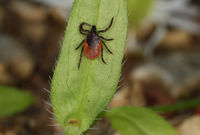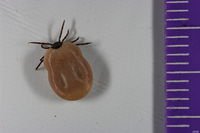Ixodes ricinus
| Literature database |
|---|
| 619 articles sorted by: |
| • year (descending) |
| • research topics |
| • countries/regions |
| • list of natural enemies |
Ixodes ricinus Linnaeus - (sheep tick)
The tick is common in Europe and also occurs in neighbouring regions. It is considered to be the most important vector of human diseases in Europe and can carry various viral, bacterial and protozoan agents. For example it transmits Lyme borreliosis and tick-borne encephalitis to humans or erlichiosis and babesiosis to domestic animals. In central Europe, where it is obligatory to report Lyme borreliosis, between 20 and 300 cases are registered per 100,000 persons per year.
The main hosts of the larval and nymphal stages are small rodents while adults feed on larger mammals, including humans. Other hosts include ground-foraging birds or reptiles. The use of repellents is recommended in areas with high tick infestations. The life cyle from egg, over larval and nymphal stages, to mature adult lasts 2-3 years, with inactive periods during the winter.
| Vernacular names | |
|---|---|
| • Deutsch: | Gemeiner Holzbock |
| • English: | sheep tick |
| • Español: | garrapata de las semillas del ricino |
| • Français: | tique du mouton |
The ticks spent considerable time waiting for a suitable host to pass by. The larvae and nymphal stages feed for only 3-5 days before leaving their host for moulting. The adults feed much longer. They are brown or reddish brown and 3-4 mm large, up to 10 mm when engorged.
For details see the respective page in Wikipedia.
- Other images of Ixodes ricinus (Wikimedia Commons - click to enlarge)





